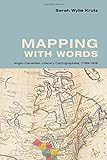Mapping with Words : Anglo-Canadian Literary Cartographies, 1789-1916 / Sarah Wylie Krotz.
Material type: TextPublisher: Toronto : University of Toronto Press, [2018]Copyright date: ©2018Description: 1 online resource (272 p.)Content type:
TextPublisher: Toronto : University of Toronto Press, [2018]Copyright date: ©2018Description: 1 online resource (272 p.)Content type: - 9781442622265
- Canadian literature -- 19th century -- History and criticism
- Canadian literature -- 20th century -- History and criticism
- Cartography in literature
- LITERARY CRITICISM / Canadian
- Canadian
- cartography
- century
- colonial
- early
- history
- landscape
- literary
- literature
- natural
- nineteenth
- poetry
- settler
- spatiality
- writing
- 810.92 23
- online - DeGruyter
| Item type | Current library | Call number | URL | Status | Notes | Barcode | |
|---|---|---|---|---|---|---|---|
 eBook
eBook
|
Biblioteca "Angelicum" Pont. Univ. S.Tommaso d'Aquino Nuvola online | online - DeGruyter (Browse shelf(Opens below)) | Online access | Not for loan (Accesso limitato) | Accesso per gli utenti autorizzati / Access for authorized users | (dgr)9781442622265 |
Browsing Biblioteca "Angelicum" Pont. Univ. S.Tommaso d'Aquino shelves, Shelving location: Nuvola online Close shelf browser (Hides shelf browser)
Frontmatter -- Contents -- Preface -- Acknowledgments -- Introduction: Maps and Text-Maps -- 1. Illuminating the Horizon: The Cartographic Aesthetics of Two Early Long Poems -- 2. The Land up Close: Mapping Disorder in Roughing It in the Bush -- 3. The Intimate Geography of Wilderness: The Spatiality of Catharine Parr Traill’s Botanical Inventories -- 4. Writing and Reading the Northwest: George Monro Grant and the Palimpsest of Settler Space -- 5. The Poet in Treaty Territory: The Literary Cartography of “The Height of Land” -- Conclusion: Maps and Counter-Maps (On Getting Lost) -- Appendix of Figures -- Notes -- Bibliography -- Index
restricted access online access with authorization star
http://purl.org/coar/access_right/c_16ec
Mapping with Words re-conceptualizes settler writing as literary cartography. The topographical descriptions of early Canadian settler writers generated not only picturesque and sublime landscapes, but also verbal maps. These worked to orient readers, reinforcing and expanding the cartographic order of the emerging colonial dominion. Drawing upon the work of critical and cultural geographers as well as literary theorists, Sarah Wylie Krotz opens up important aesthetic and political dimensions of both familiar and obscure texts from the nineteenth century, including Thomas Cary’s Abram’s Plains, George Monro Grant’s Ocean to Ocean, and Susanna Moodie’s Roughing it in the Bush. Highlighting the complex territoriality that emerges from their cartographic aesthetics, Krotz offers fresh readings of these texts, illuminating their role in an emerging spatial imaginary that was at once deeply invested in the production of colonial spaces and at the same time enmeshed in the realities of confronting Indigenous sovereignties.
Mode of access: Internet via World Wide Web.
In English.
Description based on online resource; title from PDF title page (publisher's Web site, viewed 25. Jun 2024)









